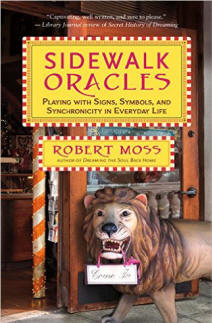Every had a feeling that made the hair on your arms rise up–in a good way? A dream that seemed important, and then chunks of it started happening in waking life? A coincidence that you knew was a special moment? Yeah, me, too.

A sundial seen on my morning walk. It’s fastened onto a tree stump, and fastened in such a way that it can’t tell the time correctly. What does that tell you about how you see time?
You and I are kairomancers–people who recognize special moments and make the most of them. Kairos, in Greek, is an opening that allows for something special to happen. If you remember Homer’s Odyssey, the hero fires his flaming arrow through a dozen ax handle holes to prove his skill.
Today’s kairomancer sees small openings and opportunities and makes the most of them. What kind of opportunity? Here’s an example: I was teaching in Washington, D.C., and had just gotten off the metro.
At the top of the escalator stood a man who was clearly lost. I used to live in the area, so I asked if I could help. Worst case scenario, I could sympathize.
The man was looking for an office in the building I was teaching in that day. Lucky guess, I thought. We walked to the building and I walked him through a maze of hallways and showed him the office. I then taught my scheduled class. At the end of the day, as I was packing up and ready to head for the airport, when Mr. Lost walked back into the class. He was friends with someone who had enjoyed the class. He wanted to know if I could create a custom class for his team. I could. I did. And I would never have had the opportunity if I had not stopped to ask if he was lost. That’s kairomancy in action.
I didn’t ask him if he was lost because I was hoping for a job. I asked because it was likely I could help. The rest unspooled on its own. Worth the risk of being helpful.
Sure, you can call it synchronicity, but I don’t think it’s random. I think we get tiny threads of opportunity and if we pull the thread, we may discover meanings that work out to our advantage. You can call it responding to the universe, living life awake, or even praying for success. I call it kairomancy because the man I learned it from calls it that.

This is the cover of the Robert Moss book that started my work in kairomancy.
Robert Moss is the author of several books (and workshops) on dream work, coincidences, and, well, kairomancy. One of my favorites is Sidewalk Oracles, Playing with Signs, Symbols, and Synchronicity in Everyday Life. The book is a series of stories, games, and experiments that you can do every day to enhance your intuition and help make yourself more aware of signs and symbols in your life. “Instead of walking through life tuned in to an unproductive inner soundtrack, the kairomancer feels the sidewalk she treads, hears the messages awaiting receipt, and sees the extraordinary in the ordinary,” Moss says.
Moss tells us to “marry our field,”–to look for ways to work deeply in the area that interests us. For me, that is working with words and symbols, helping other people to speak and write clearly enough to be heard. We all long to be heard and understood, but we often can’t do it because we don’t have the tools or we don’t understand the rules.
Here’s how I learned to “marry my field.” Every morning, I walk three to five miles. I do it for medical reasons, but somewhere along the line, I realize that distance walking every morning made me feel more alive, more calm, more ready to deal with the problems that life brings people who teach what they do. Ready to face the to-do list of the day.
While walking, I saw symbols. I listened to my intuition. And slowly, because I paid attention, I created ways to become a pass-through for my coaching clients. They became more attuned to their own power, their own strength.
In the next few blog posts, I’m going to talk about what happens on my morning walk. Come along, if you’d like to. It’s never boring. And if you keep a journal, you might find some new ways to write about your life, too. Let’s go!
—Quinn McDonald is a writer and creativity coach. She helps people discover the deep longing inside and connect it to a life’s work.
 And sometimes, just because the sun is at the right angle, because I looked up, because the seed pods had light shining through them, sometimes I can see the future.
And sometimes, just because the sun is at the right angle, because I looked up, because the seed pods had light shining through them, sometimes I can see the future.



















